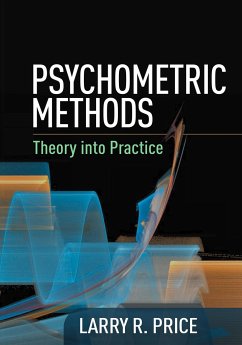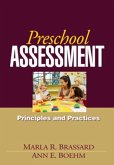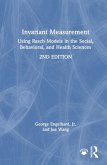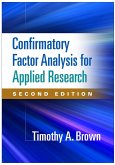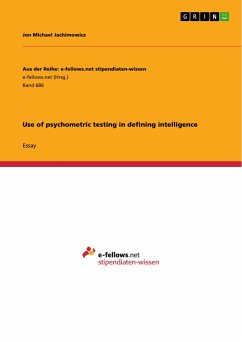- Gebundenes Buch
- Merkliste
- Auf die Merkliste
- Bewerten Bewerten
- Teilen
- Produkt teilen
- Produkterinnerung
- Produkterinnerung
Grounded in current knowledge and professional practice, this book provides up-to-date coverage of psychometric theory, methods, and interpretation of results. Essential topics include measurement and statistical concepts, scaling models, test design and development, reliability, validity, factor analysis, item response theory, and generalizability theory. Also addressed are norming and test equating, topics not typically covered in traditional psychometrics texts. Examples drawn from a dataset on intelligence testing are used throughout the book, elucidating the assumptions underlying…mehr
Andere Kunden interessierten sich auch für
![Frontiers of Test Validity Theory Frontiers of Test Validity Theory]() Keith A MarkusFrontiers of Test Validity Theory187,99 €
Keith A MarkusFrontiers of Test Validity Theory187,99 €![Preschool Assessment Preschool Assessment]() Marla R BrassardPreschool Assessment114,99 €
Marla R BrassardPreschool Assessment114,99 €![Invariant Measurement Invariant Measurement]() George Engelhard JrInvariant Measurement187,99 €
George Engelhard JrInvariant Measurement187,99 €![Assessment Engineering in Test Design Assessment Engineering in Test Design]() Richard M LuechtAssessment Engineering in Test Design180,99 €
Richard M LuechtAssessment Engineering in Test Design180,99 €![Confirmatory Factor Analysis for Applied Research Confirmatory Factor Analysis for Applied Research]() Timothy A BrownConfirmatory Factor Analysis for Applied Research123,99 €
Timothy A BrownConfirmatory Factor Analysis for Applied Research123,99 €![Use of psychometric testing in defining intelligence Use of psychometric testing in defining intelligence]() Jon Michael JachimowiczUse of psychometric testing in defining intelligence15,95 €
Jon Michael JachimowiczUse of psychometric testing in defining intelligence15,95 €![Designing Quality Authentic Assessments Designing Quality Authentic Assessments]() Tay Hui YongDesigning Quality Authentic Assessments187,99 €
Tay Hui YongDesigning Quality Authentic Assessments187,99 €-
-
-
Grounded in current knowledge and professional practice, this book provides up-to-date coverage of psychometric theory, methods, and interpretation of results. Essential topics include measurement and statistical concepts, scaling models, test design and development, reliability, validity, factor analysis, item response theory, and generalizability theory. Also addressed are norming and test equating, topics not typically covered in traditional psychometrics texts. Examples drawn from a dataset on intelligence testing are used throughout the book, elucidating the assumptions underlying particular methods and providing SPSS (or alternative) syntax for conducting analyses.
Hinweis: Dieser Artikel kann nur an eine deutsche Lieferadresse ausgeliefert werden.
Hinweis: Dieser Artikel kann nur an eine deutsche Lieferadresse ausgeliefert werden.
Produktdetails
- Produktdetails
- Verlag: Guilford Publications
- Seitenzahl: 552
- Erscheinungstermin: 12. Dezember 2016
- Englisch
- Abmessung: 261mm x 187mm x 32mm
- Gewicht: 1170g
- ISBN-13: 9781462524778
- ISBN-10: 146252477X
- Artikelnr.: 43424781
- Herstellerkennzeichnung
- Libri GmbH
- Europaallee 1
- 36244 Bad Hersfeld
- gpsr@libri.de
- Verlag: Guilford Publications
- Seitenzahl: 552
- Erscheinungstermin: 12. Dezember 2016
- Englisch
- Abmessung: 261mm x 187mm x 32mm
- Gewicht: 1170g
- ISBN-13: 9781462524778
- ISBN-10: 146252477X
- Artikelnr.: 43424781
- Herstellerkennzeichnung
- Libri GmbH
- Europaallee 1
- 36244 Bad Hersfeld
- gpsr@libri.de
Larry R. Price, PhD, is Professor of Psychometrics and Statistics at Texas State University. Previously, he served as a psychometrician and statistician at the Emory University School of Medicine (Department of Psychiatry and Behavioral Sciences) and at the Psychological Corporation (now part of Pearson's Clinical Assessment Group). Dr. Price is a Fellow of the American Psychological Association, Division 5 (Evaluation, Measurement, and Statistics), and an Accredited Professional Statistician of the American Statistical Association.
1. Introduction
1.1 Psychological Measurement and Tests
1.2 Tests and Samples of Behavior
1.3 Types of Tests
1.4 Origin of Psychometrics
1.5 Definition of Measurement
1.6 Measuring Behavior
1.7 Psychometrics and Its Importance to Research and Practice
1.8 Organization of This Book
Key Terms and Definitions
2. Measurement and Statistical Concepts
2.1 Introduction
2.2 Numbers and Measurement
2.3 Properties of Measurement in Relation to Numbers
2.4 Levels of Measurement
2.5 Contemporary View on the Levels of Measurement and Scaling
2.6 Statistical Foundations for Psychometrics
2.7 Variables, Frequency Distributions, and Scores
2.8 Summation or Sigma Notation
2.9 Shape, Central Tendency, and Variability of Score Distributions
2.10 Correlation, Covariance, and Regression
2.11 Summary
Key Terms and Definitions
3. Criterion, Content, and Construct Validity
3.1 Introduction
3.2 Criterion Validity
3.3 Essential Elements of a High-Quality Criterion
3.4 Statistical Estimation of Criterion Validity
3.5 Correction for Attenuation
3.6 Limitations to Using the Correction for Attenuation
3.7 Estimating Criterion Validity with Multiple Predictors: Partial
Correlation
3.8 Estimating Criterion Validity with Multiple Predictors: Higher-Order
Partial Correlation
3.9 Coefficient of Multiple Determination and Multiple Correlation
3.10 Estimating Criterion Validity with More Than One Predictor: Multiple
Linear Regression
3.11 Regression Analysis for Estimating Criterion Validity: Development of
the Regression Equation
3.12 Unstandardized Regression Equation for Multiple Regression
3.13 Testing the Regression Equation for Significance
3.14 Partial Regression Slopes
3.15 Standardized Regression Equation
3.16 Predictive Accuracy of a Regression Analysis
3.17 Predictor Subset Selection in Regression
3.18 Summary
Key Terms and Definitions
4. Statistical Aspects of the Validation Process
4.1 Techniques for Classification and Selection
4.2 Discriminant Analysis
4.3 Multiple-Group Discriminant Analysis
4.4 Logistic Regression
4.5 Logistic Multiple Discriminant Analysis: Multinomial Logistic
Regression
4.6 Model Fit in Logistic Regression
4.7 Content Validity
4.8 Limitations of the Content Validity Model
4.9 Construct Validity
4.10 Establishing Evidence of Construct Validity
4.11 Correlational Evidence of Construct Validity
4.12 Group Differentiation Studies of Construct Validity
4.13 Factor Analysis and Construct Validity
4.14 Multitrait-Multimethod Studies
4.15 Generalizability Theory and Construct Validity
4.16 Summary and Conclusions
Key Terms and Definitions
5. Scaling
5.1 Introduction
5.2 A Brief History of Scaling
5.3 Psychophysical versus Psychological Scaling
5.4 Why Scaling Models Are Important
5.5 Types of Scaling Models
5.6 Stimulus-Centered Scaling
5.7 Thurstone's Law of Comparative Judgment
5.8 Response-Centered Scaling
5.9 Scaling Models Involving Order
5.10 Guttman Scaling
5.11 The Unfolding Technique
5.12 Subject-Centered Scaling
5.13 Data Organization and Missing Data
5.14 Incomplete and Missing Data
5.15 Summary and Conclusions
Key Terms and Definitions
6. Test Development
6.1 Introduction
6.2 Guidelines for Test and Instrument Development
6.3 Item Analysis
6.4 Item Difficulty
6.5 Item Discrimination
6.6 Point-Biserial Correlation
6.7 Biserial Correlation
6.8 Phi Coefficient
6.9 Tetrachoric Correlation
6.10 Item Reliability and Validity
6.11 Standard Setting
6.12 Standard-Setting Approaches
6.13 The Nedelsky Method
6.14 The Ebel Method
6.15 The Angoff Method and Modifications
6.16 The Bookmark Method
6.17 Summary and Conclusions
Key Terms and Definitions
7. Reliability
7.1 Introduction
7.2 Conceptual Overview
7.3 The True Score Model
7.4 Probability Theory, True Score Model, and Random Variables
7.5 Properties and Assumptions of the True Score Model
7.6 True Score Equivalence, Essential True Score Equivalence, and
Congeneric Tests
7.7 Relationship between Observed and True Scores
7.8 The Reliability Index and Its Relationship to the Reliability
Coefficient
7.9 Summarizing the Ways to Conceptualize Reliability
7.10 Reliability of a Composite
7.11 Coefficient of Reliability: Methods of Estimation Based on Two
Occasions
7.12 Methods Based on a Single Testing Occasion
7.13 Estimating Coefficient Alpha: Computer Programs and Example Data
7.14 Reliability of Composite Scores Based on Coefficient Alpha
7.15 Reliability Estimation Using the Analysis of Variance Method
7.16 Reliability of Difference Scores
7.17 Application of the Reliability of Difference Scores
7.18 Errors of Measurement and Confidence Intervals
7.19 Standard Error of Measurement
7.20 Standard Error of Prediction
7.21 Summarizing and Reporting Reliability Information
7.22 Summary and Conclusions
Key Terms and Definitions
8. Generalizability Theory
8.1 Introduction
8.2 Purpose of Generalizability Theory
8.3 Facets of Measurement and Universe Scores
8.4 How Generalizability Theory Extends Classical Test Theory
8.5 Generalizability Theory and Analysis of Variance
8.6 General Steps in Conducting a Generalizability Theory Analysis
8.7 Statistical Model for Generalizability Theory
8.8 Design 1: Single-Facet Person by Item Analysis
8.9 Proportion of Variance for the p x i Design
8.10 Generalizability Coefficient and CTT Reliability
8.11 Design 2: Single-Facet Crossed Design with Multiple Raters
8.12 Design 3: Single-Facet Design with the Same Raters on Multiple
Occasions
8.13 Design 4: Single-Facet Nested Design with Multiple Raters
8.14 Design 5: Single-Facet Design Multiple Raters Rating on Two Occasions
8.15 Standard Errors of Measurement: Designs 1-5
8.16 Two-Facet Designs
8.17 Summary and Conclusions
Key Terms and Definitions
9. Factor Analysis
9.1 Introduction
9.2 Brief History
9.3 Applied Example with GfGc Data
9.4 Estimating Factors and Factor Loadings
9.5 Factor Rotation
9.6 Correlated Factors and Simple Structure
9.7 The Factor Analysis Model, Communality, and Uniqueness
9.8 Components, Eigenvalues, and Eigenvectors
9.9 Distinction between Principal Components Analysis and Factor Analysis
9.10 Confirmatory Factor Analysis
9.11 Confirmatory Factor Analysis and Structural Equation Modeling
9.12 Conducting Factor Analysis: Common Errors to Avoid
9.13 Summary and Conclusions
Key Terms and Definitions
10. Item Response Theory
10.1 Introduction
10.2 How IRT Differs from CTT
10.3 Introduction to IRT
10.4 Strong True Sco
1.1 Psychological Measurement and Tests
1.2 Tests and Samples of Behavior
1.3 Types of Tests
1.4 Origin of Psychometrics
1.5 Definition of Measurement
1.6 Measuring Behavior
1.7 Psychometrics and Its Importance to Research and Practice
1.8 Organization of This Book
Key Terms and Definitions
2. Measurement and Statistical Concepts
2.1 Introduction
2.2 Numbers and Measurement
2.3 Properties of Measurement in Relation to Numbers
2.4 Levels of Measurement
2.5 Contemporary View on the Levels of Measurement and Scaling
2.6 Statistical Foundations for Psychometrics
2.7 Variables, Frequency Distributions, and Scores
2.8 Summation or Sigma Notation
2.9 Shape, Central Tendency, and Variability of Score Distributions
2.10 Correlation, Covariance, and Regression
2.11 Summary
Key Terms and Definitions
3. Criterion, Content, and Construct Validity
3.1 Introduction
3.2 Criterion Validity
3.3 Essential Elements of a High-Quality Criterion
3.4 Statistical Estimation of Criterion Validity
3.5 Correction for Attenuation
3.6 Limitations to Using the Correction for Attenuation
3.7 Estimating Criterion Validity with Multiple Predictors: Partial
Correlation
3.8 Estimating Criterion Validity with Multiple Predictors: Higher-Order
Partial Correlation
3.9 Coefficient of Multiple Determination and Multiple Correlation
3.10 Estimating Criterion Validity with More Than One Predictor: Multiple
Linear Regression
3.11 Regression Analysis for Estimating Criterion Validity: Development of
the Regression Equation
3.12 Unstandardized Regression Equation for Multiple Regression
3.13 Testing the Regression Equation for Significance
3.14 Partial Regression Slopes
3.15 Standardized Regression Equation
3.16 Predictive Accuracy of a Regression Analysis
3.17 Predictor Subset Selection in Regression
3.18 Summary
Key Terms and Definitions
4. Statistical Aspects of the Validation Process
4.1 Techniques for Classification and Selection
4.2 Discriminant Analysis
4.3 Multiple-Group Discriminant Analysis
4.4 Logistic Regression
4.5 Logistic Multiple Discriminant Analysis: Multinomial Logistic
Regression
4.6 Model Fit in Logistic Regression
4.7 Content Validity
4.8 Limitations of the Content Validity Model
4.9 Construct Validity
4.10 Establishing Evidence of Construct Validity
4.11 Correlational Evidence of Construct Validity
4.12 Group Differentiation Studies of Construct Validity
4.13 Factor Analysis and Construct Validity
4.14 Multitrait-Multimethod Studies
4.15 Generalizability Theory and Construct Validity
4.16 Summary and Conclusions
Key Terms and Definitions
5. Scaling
5.1 Introduction
5.2 A Brief History of Scaling
5.3 Psychophysical versus Psychological Scaling
5.4 Why Scaling Models Are Important
5.5 Types of Scaling Models
5.6 Stimulus-Centered Scaling
5.7 Thurstone's Law of Comparative Judgment
5.8 Response-Centered Scaling
5.9 Scaling Models Involving Order
5.10 Guttman Scaling
5.11 The Unfolding Technique
5.12 Subject-Centered Scaling
5.13 Data Organization and Missing Data
5.14 Incomplete and Missing Data
5.15 Summary and Conclusions
Key Terms and Definitions
6. Test Development
6.1 Introduction
6.2 Guidelines for Test and Instrument Development
6.3 Item Analysis
6.4 Item Difficulty
6.5 Item Discrimination
6.6 Point-Biserial Correlation
6.7 Biserial Correlation
6.8 Phi Coefficient
6.9 Tetrachoric Correlation
6.10 Item Reliability and Validity
6.11 Standard Setting
6.12 Standard-Setting Approaches
6.13 The Nedelsky Method
6.14 The Ebel Method
6.15 The Angoff Method and Modifications
6.16 The Bookmark Method
6.17 Summary and Conclusions
Key Terms and Definitions
7. Reliability
7.1 Introduction
7.2 Conceptual Overview
7.3 The True Score Model
7.4 Probability Theory, True Score Model, and Random Variables
7.5 Properties and Assumptions of the True Score Model
7.6 True Score Equivalence, Essential True Score Equivalence, and
Congeneric Tests
7.7 Relationship between Observed and True Scores
7.8 The Reliability Index and Its Relationship to the Reliability
Coefficient
7.9 Summarizing the Ways to Conceptualize Reliability
7.10 Reliability of a Composite
7.11 Coefficient of Reliability: Methods of Estimation Based on Two
Occasions
7.12 Methods Based on a Single Testing Occasion
7.13 Estimating Coefficient Alpha: Computer Programs and Example Data
7.14 Reliability of Composite Scores Based on Coefficient Alpha
7.15 Reliability Estimation Using the Analysis of Variance Method
7.16 Reliability of Difference Scores
7.17 Application of the Reliability of Difference Scores
7.18 Errors of Measurement and Confidence Intervals
7.19 Standard Error of Measurement
7.20 Standard Error of Prediction
7.21 Summarizing and Reporting Reliability Information
7.22 Summary and Conclusions
Key Terms and Definitions
8. Generalizability Theory
8.1 Introduction
8.2 Purpose of Generalizability Theory
8.3 Facets of Measurement and Universe Scores
8.4 How Generalizability Theory Extends Classical Test Theory
8.5 Generalizability Theory and Analysis of Variance
8.6 General Steps in Conducting a Generalizability Theory Analysis
8.7 Statistical Model for Generalizability Theory
8.8 Design 1: Single-Facet Person by Item Analysis
8.9 Proportion of Variance for the p x i Design
8.10 Generalizability Coefficient and CTT Reliability
8.11 Design 2: Single-Facet Crossed Design with Multiple Raters
8.12 Design 3: Single-Facet Design with the Same Raters on Multiple
Occasions
8.13 Design 4: Single-Facet Nested Design with Multiple Raters
8.14 Design 5: Single-Facet Design Multiple Raters Rating on Two Occasions
8.15 Standard Errors of Measurement: Designs 1-5
8.16 Two-Facet Designs
8.17 Summary and Conclusions
Key Terms and Definitions
9. Factor Analysis
9.1 Introduction
9.2 Brief History
9.3 Applied Example with GfGc Data
9.4 Estimating Factors and Factor Loadings
9.5 Factor Rotation
9.6 Correlated Factors and Simple Structure
9.7 The Factor Analysis Model, Communality, and Uniqueness
9.8 Components, Eigenvalues, and Eigenvectors
9.9 Distinction between Principal Components Analysis and Factor Analysis
9.10 Confirmatory Factor Analysis
9.11 Confirmatory Factor Analysis and Structural Equation Modeling
9.12 Conducting Factor Analysis: Common Errors to Avoid
9.13 Summary and Conclusions
Key Terms and Definitions
10. Item Response Theory
10.1 Introduction
10.2 How IRT Differs from CTT
10.3 Introduction to IRT
10.4 Strong True Sco
1. Introduction
1.1 Psychological Measurement and Tests
1.2 Tests and Samples of Behavior
1.3 Types of Tests
1.4 Origin of Psychometrics
1.5 Definition of Measurement
1.6 Measuring Behavior
1.7 Psychometrics and Its Importance to Research and Practice
1.8 Organization of This Book
Key Terms and Definitions
2. Measurement and Statistical Concepts
2.1 Introduction
2.2 Numbers and Measurement
2.3 Properties of Measurement in Relation to Numbers
2.4 Levels of Measurement
2.5 Contemporary View on the Levels of Measurement and Scaling
2.6 Statistical Foundations for Psychometrics
2.7 Variables, Frequency Distributions, and Scores
2.8 Summation or Sigma Notation
2.9 Shape, Central Tendency, and Variability of Score Distributions
2.10 Correlation, Covariance, and Regression
2.11 Summary
Key Terms and Definitions
3. Criterion, Content, and Construct Validity
3.1 Introduction
3.2 Criterion Validity
3.3 Essential Elements of a High-Quality Criterion
3.4 Statistical Estimation of Criterion Validity
3.5 Correction for Attenuation
3.6 Limitations to Using the Correction for Attenuation
3.7 Estimating Criterion Validity with Multiple Predictors: Partial
Correlation
3.8 Estimating Criterion Validity with Multiple Predictors: Higher-Order
Partial Correlation
3.9 Coefficient of Multiple Determination and Multiple Correlation
3.10 Estimating Criterion Validity with More Than One Predictor: Multiple
Linear Regression
3.11 Regression Analysis for Estimating Criterion Validity: Development of
the Regression Equation
3.12 Unstandardized Regression Equation for Multiple Regression
3.13 Testing the Regression Equation for Significance
3.14 Partial Regression Slopes
3.15 Standardized Regression Equation
3.16 Predictive Accuracy of a Regression Analysis
3.17 Predictor Subset Selection in Regression
3.18 Summary
Key Terms and Definitions
4. Statistical Aspects of the Validation Process
4.1 Techniques for Classification and Selection
4.2 Discriminant Analysis
4.3 Multiple-Group Discriminant Analysis
4.4 Logistic Regression
4.5 Logistic Multiple Discriminant Analysis: Multinomial Logistic
Regression
4.6 Model Fit in Logistic Regression
4.7 Content Validity
4.8 Limitations of the Content Validity Model
4.9 Construct Validity
4.10 Establishing Evidence of Construct Validity
4.11 Correlational Evidence of Construct Validity
4.12 Group Differentiation Studies of Construct Validity
4.13 Factor Analysis and Construct Validity
4.14 Multitrait-Multimethod Studies
4.15 Generalizability Theory and Construct Validity
4.16 Summary and Conclusions
Key Terms and Definitions
5. Scaling
5.1 Introduction
5.2 A Brief History of Scaling
5.3 Psychophysical versus Psychological Scaling
5.4 Why Scaling Models Are Important
5.5 Types of Scaling Models
5.6 Stimulus-Centered Scaling
5.7 Thurstone's Law of Comparative Judgment
5.8 Response-Centered Scaling
5.9 Scaling Models Involving Order
5.10 Guttman Scaling
5.11 The Unfolding Technique
5.12 Subject-Centered Scaling
5.13 Data Organization and Missing Data
5.14 Incomplete and Missing Data
5.15 Summary and Conclusions
Key Terms and Definitions
6. Test Development
6.1 Introduction
6.2 Guidelines for Test and Instrument Development
6.3 Item Analysis
6.4 Item Difficulty
6.5 Item Discrimination
6.6 Point-Biserial Correlation
6.7 Biserial Correlation
6.8 Phi Coefficient
6.9 Tetrachoric Correlation
6.10 Item Reliability and Validity
6.11 Standard Setting
6.12 Standard-Setting Approaches
6.13 The Nedelsky Method
6.14 The Ebel Method
6.15 The Angoff Method and Modifications
6.16 The Bookmark Method
6.17 Summary and Conclusions
Key Terms and Definitions
7. Reliability
7.1 Introduction
7.2 Conceptual Overview
7.3 The True Score Model
7.4 Probability Theory, True Score Model, and Random Variables
7.5 Properties and Assumptions of the True Score Model
7.6 True Score Equivalence, Essential True Score Equivalence, and
Congeneric Tests
7.7 Relationship between Observed and True Scores
7.8 The Reliability Index and Its Relationship to the Reliability
Coefficient
7.9 Summarizing the Ways to Conceptualize Reliability
7.10 Reliability of a Composite
7.11 Coefficient of Reliability: Methods of Estimation Based on Two
Occasions
7.12 Methods Based on a Single Testing Occasion
7.13 Estimating Coefficient Alpha: Computer Programs and Example Data
7.14 Reliability of Composite Scores Based on Coefficient Alpha
7.15 Reliability Estimation Using the Analysis of Variance Method
7.16 Reliability of Difference Scores
7.17 Application of the Reliability of Difference Scores
7.18 Errors of Measurement and Confidence Intervals
7.19 Standard Error of Measurement
7.20 Standard Error of Prediction
7.21 Summarizing and Reporting Reliability Information
7.22 Summary and Conclusions
Key Terms and Definitions
8. Generalizability Theory
8.1 Introduction
8.2 Purpose of Generalizability Theory
8.3 Facets of Measurement and Universe Scores
8.4 How Generalizability Theory Extends Classical Test Theory
8.5 Generalizability Theory and Analysis of Variance
8.6 General Steps in Conducting a Generalizability Theory Analysis
8.7 Statistical Model for Generalizability Theory
8.8 Design 1: Single-Facet Person by Item Analysis
8.9 Proportion of Variance for the p x i Design
8.10 Generalizability Coefficient and CTT Reliability
8.11 Design 2: Single-Facet Crossed Design with Multiple Raters
8.12 Design 3: Single-Facet Design with the Same Raters on Multiple
Occasions
8.13 Design 4: Single-Facet Nested Design with Multiple Raters
8.14 Design 5: Single-Facet Design Multiple Raters Rating on Two Occasions
8.15 Standard Errors of Measurement: Designs 1-5
8.16 Two-Facet Designs
8.17 Summary and Conclusions
Key Terms and Definitions
9. Factor Analysis
9.1 Introduction
9.2 Brief History
9.3 Applied Example with GfGc Data
9.4 Estimating Factors and Factor Loadings
9.5 Factor Rotation
9.6 Correlated Factors and Simple Structure
9.7 The Factor Analysis Model, Communality, and Uniqueness
9.8 Components, Eigenvalues, and Eigenvectors
9.9 Distinction between Principal Components Analysis and Factor Analysis
9.10 Confirmatory Factor Analysis
9.11 Confirmatory Factor Analysis and Structural Equation Modeling
9.12 Conducting Factor Analysis: Common Errors to Avoid
9.13 Summary and Conclusions
Key Terms and Definitions
10. Item Response Theory
10.1 Introduction
10.2 How IRT Differs from CTT
10.3 Introduction to IRT
10.4 Strong True Sco
1.1 Psychological Measurement and Tests
1.2 Tests and Samples of Behavior
1.3 Types of Tests
1.4 Origin of Psychometrics
1.5 Definition of Measurement
1.6 Measuring Behavior
1.7 Psychometrics and Its Importance to Research and Practice
1.8 Organization of This Book
Key Terms and Definitions
2. Measurement and Statistical Concepts
2.1 Introduction
2.2 Numbers and Measurement
2.3 Properties of Measurement in Relation to Numbers
2.4 Levels of Measurement
2.5 Contemporary View on the Levels of Measurement and Scaling
2.6 Statistical Foundations for Psychometrics
2.7 Variables, Frequency Distributions, and Scores
2.8 Summation or Sigma Notation
2.9 Shape, Central Tendency, and Variability of Score Distributions
2.10 Correlation, Covariance, and Regression
2.11 Summary
Key Terms and Definitions
3. Criterion, Content, and Construct Validity
3.1 Introduction
3.2 Criterion Validity
3.3 Essential Elements of a High-Quality Criterion
3.4 Statistical Estimation of Criterion Validity
3.5 Correction for Attenuation
3.6 Limitations to Using the Correction for Attenuation
3.7 Estimating Criterion Validity with Multiple Predictors: Partial
Correlation
3.8 Estimating Criterion Validity with Multiple Predictors: Higher-Order
Partial Correlation
3.9 Coefficient of Multiple Determination and Multiple Correlation
3.10 Estimating Criterion Validity with More Than One Predictor: Multiple
Linear Regression
3.11 Regression Analysis for Estimating Criterion Validity: Development of
the Regression Equation
3.12 Unstandardized Regression Equation for Multiple Regression
3.13 Testing the Regression Equation for Significance
3.14 Partial Regression Slopes
3.15 Standardized Regression Equation
3.16 Predictive Accuracy of a Regression Analysis
3.17 Predictor Subset Selection in Regression
3.18 Summary
Key Terms and Definitions
4. Statistical Aspects of the Validation Process
4.1 Techniques for Classification and Selection
4.2 Discriminant Analysis
4.3 Multiple-Group Discriminant Analysis
4.4 Logistic Regression
4.5 Logistic Multiple Discriminant Analysis: Multinomial Logistic
Regression
4.6 Model Fit in Logistic Regression
4.7 Content Validity
4.8 Limitations of the Content Validity Model
4.9 Construct Validity
4.10 Establishing Evidence of Construct Validity
4.11 Correlational Evidence of Construct Validity
4.12 Group Differentiation Studies of Construct Validity
4.13 Factor Analysis and Construct Validity
4.14 Multitrait-Multimethod Studies
4.15 Generalizability Theory and Construct Validity
4.16 Summary and Conclusions
Key Terms and Definitions
5. Scaling
5.1 Introduction
5.2 A Brief History of Scaling
5.3 Psychophysical versus Psychological Scaling
5.4 Why Scaling Models Are Important
5.5 Types of Scaling Models
5.6 Stimulus-Centered Scaling
5.7 Thurstone's Law of Comparative Judgment
5.8 Response-Centered Scaling
5.9 Scaling Models Involving Order
5.10 Guttman Scaling
5.11 The Unfolding Technique
5.12 Subject-Centered Scaling
5.13 Data Organization and Missing Data
5.14 Incomplete and Missing Data
5.15 Summary and Conclusions
Key Terms and Definitions
6. Test Development
6.1 Introduction
6.2 Guidelines for Test and Instrument Development
6.3 Item Analysis
6.4 Item Difficulty
6.5 Item Discrimination
6.6 Point-Biserial Correlation
6.7 Biserial Correlation
6.8 Phi Coefficient
6.9 Tetrachoric Correlation
6.10 Item Reliability and Validity
6.11 Standard Setting
6.12 Standard-Setting Approaches
6.13 The Nedelsky Method
6.14 The Ebel Method
6.15 The Angoff Method and Modifications
6.16 The Bookmark Method
6.17 Summary and Conclusions
Key Terms and Definitions
7. Reliability
7.1 Introduction
7.2 Conceptual Overview
7.3 The True Score Model
7.4 Probability Theory, True Score Model, and Random Variables
7.5 Properties and Assumptions of the True Score Model
7.6 True Score Equivalence, Essential True Score Equivalence, and
Congeneric Tests
7.7 Relationship between Observed and True Scores
7.8 The Reliability Index and Its Relationship to the Reliability
Coefficient
7.9 Summarizing the Ways to Conceptualize Reliability
7.10 Reliability of a Composite
7.11 Coefficient of Reliability: Methods of Estimation Based on Two
Occasions
7.12 Methods Based on a Single Testing Occasion
7.13 Estimating Coefficient Alpha: Computer Programs and Example Data
7.14 Reliability of Composite Scores Based on Coefficient Alpha
7.15 Reliability Estimation Using the Analysis of Variance Method
7.16 Reliability of Difference Scores
7.17 Application of the Reliability of Difference Scores
7.18 Errors of Measurement and Confidence Intervals
7.19 Standard Error of Measurement
7.20 Standard Error of Prediction
7.21 Summarizing and Reporting Reliability Information
7.22 Summary and Conclusions
Key Terms and Definitions
8. Generalizability Theory
8.1 Introduction
8.2 Purpose of Generalizability Theory
8.3 Facets of Measurement and Universe Scores
8.4 How Generalizability Theory Extends Classical Test Theory
8.5 Generalizability Theory and Analysis of Variance
8.6 General Steps in Conducting a Generalizability Theory Analysis
8.7 Statistical Model for Generalizability Theory
8.8 Design 1: Single-Facet Person by Item Analysis
8.9 Proportion of Variance for the p x i Design
8.10 Generalizability Coefficient and CTT Reliability
8.11 Design 2: Single-Facet Crossed Design with Multiple Raters
8.12 Design 3: Single-Facet Design with the Same Raters on Multiple
Occasions
8.13 Design 4: Single-Facet Nested Design with Multiple Raters
8.14 Design 5: Single-Facet Design Multiple Raters Rating on Two Occasions
8.15 Standard Errors of Measurement: Designs 1-5
8.16 Two-Facet Designs
8.17 Summary and Conclusions
Key Terms and Definitions
9. Factor Analysis
9.1 Introduction
9.2 Brief History
9.3 Applied Example with GfGc Data
9.4 Estimating Factors and Factor Loadings
9.5 Factor Rotation
9.6 Correlated Factors and Simple Structure
9.7 The Factor Analysis Model, Communality, and Uniqueness
9.8 Components, Eigenvalues, and Eigenvectors
9.9 Distinction between Principal Components Analysis and Factor Analysis
9.10 Confirmatory Factor Analysis
9.11 Confirmatory Factor Analysis and Structural Equation Modeling
9.12 Conducting Factor Analysis: Common Errors to Avoid
9.13 Summary and Conclusions
Key Terms and Definitions
10. Item Response Theory
10.1 Introduction
10.2 How IRT Differs from CTT
10.3 Introduction to IRT
10.4 Strong True Sco

